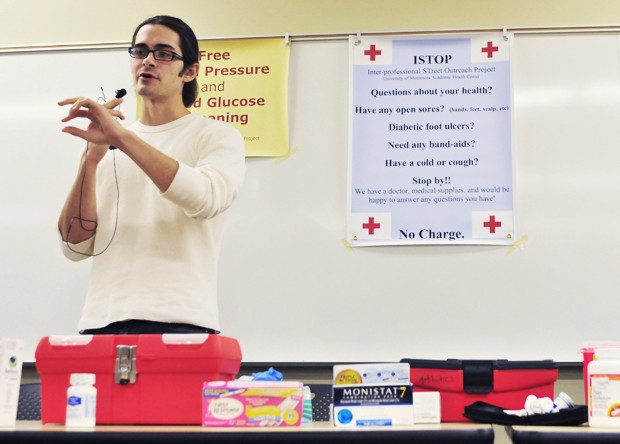When Carolyn Bramante began working with the homeless, she could provide a hot meal but couldnâÄôt treat a bad cut on the road to infection. âÄúI thought, man, even simple health care âĦ it could really go a long way,âÄù Bramante said. So the second-year medical student founded the Inter-professional Street Outreach Project (ISTOP), which has about 40 active members including University of Minnesota students in nursing, public health, pharmacy, physical therapy and medicine. Since February, about every other week students and a preceptor âÄî a medical official from the University or general medical community âÄî will load duffel bags with supplies and travel to a womenâÄôs shelter or church. They spend the first 20 minutes talking with people and setting up in a corner. For the next hour they check temperatures and pulses, treat basic cuts and fungal infections, pass out wound care kits and medicine like cough drops. Bramante said she has seen many people who wanted to go to the emergency room and didnâÄôt need to. By providing basic care or directing people to a free clinic, the organization averts expensive costs to the healthcare system, Bramante said. On Oct. 7 ISTOP began providing care in the basement of Holy Rosary church, where Loaves and Fishes offers free dinners. Laura Wallace, outreach coordinator at Holy Rosary, said the ISTOP is unique, and serves âÄúa transient population who might not access care otherwise.âÄù The students provide a constant presence for a population who may have had negative experiences with health care in the past, Jake Feigal, a second-year medical student and ISTOP co-chair said. On her last visit to a homeless shelter, ISTOP volunteer and nursing and psychology student Anna Grossbach showed kids how to sneeze into their elbow and wash their hands. âÄúItâÄôs the simple things that can make a big difference,âÄù she said. âÄúWhatâÄôs most enjoyable is seeing whatâÄôs out there, itâÄôs not what you read about in books,âÄù Grossbach said. The first couple years of medical school students spend a lot of time thinking about themselves, Bramante said. âÄúItâÄôs nice for students to be thinking about serving others,âÄù she said. Grossbach said having students from across different medical professions is important because patients fall through the cracks when the disciplines canâÄôt communicate with each other. Physical therapy students help at Women of Nations shelter once a month. They discuss exercise, pain management, and screen for diabetes, second-year physical therapy student John Egge said. The students listen to the women and childrenâÄôs needs but make a point to not judge them, April Witschen, assistant program director at Women of Nations, said. âÄúSomeone can sense when theyâÄôre being judged, [they] put up an extra wall,âÄù Feigal said. Bramante said the homeless have often been mistreated by the health care system, but with ISTOP she has had 15 people thank her for being there. Bramante wants to expand the project and take it to the streets. There is a population of the homeless who wonâÄôt go to service agencies, ISTOP faculty advisor and University professor Dr. John Song said. The program is working on the logistics of visiting encampments, but liability problems and safety issues must be handled first, Song said. Another limiting factor is the number of licensed physician volunteers, Song said. Due to busy schedules, ISTOP has only about five active preceptors, but needs about 20.

Image by Chelsey Rosetter
University second-year medical student Jacob Feigal gives a demonstration Monday during a training session for potential ISTOP members.
Students provide health care for the homeless
More than 40 students visit shelters and churches, providing basic care and consults for Minnesota’s homeless.
Published November 2, 2009
0

